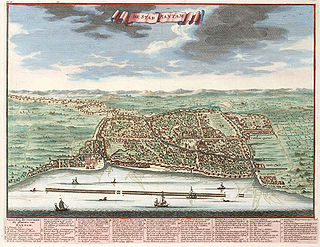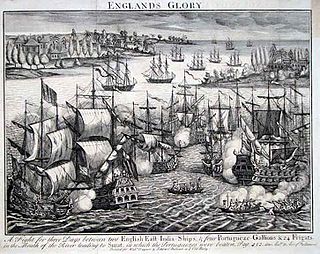| |||||
| Centuries: | |||||
|---|---|---|---|---|---|
| Decades: | |||||
| See also: | Other events of 1676 List of years in Ireland | ||||
Events from the year 1676 in Ireland.
| |||||
| Centuries: | |||||
|---|---|---|---|---|---|
| Decades: | |||||
| See also: | Other events of 1676 List of years in Ireland | ||||
Events from the year 1676 in Ireland.
July 31 is the 212th day of the year in the Gregorian calendar. There are 153 days remaining until the end of the year.
Viscount Lanesborough is a title that has been created twice in the Peerage of Ireland. The first creation came on 31 July 1676 in favour Sir George Lane, 2nd Baronet. The titles became extinct upon the death of his son, the second Viscount, on 2 August 1724. The Lane Baronetcy, of Tulske in the County of Roscommon, had been created in the Baronetage of Ireland on 9 February 1661 for Richard Lane. The second creation came on 12 August 1728 in favour Brinsley Butler, 2nd Baron Newtown-Butler. His son Humphrey was created Earl of Lanesborough in 1756. See the latter title for more information on this creation.
The Peerage of Ireland consists of those titles of nobility created by the English monarchs in their capacity as Lord or King of Ireland, or later by monarchs of the United Kingdom of Great Britain and Ireland. The creation of such titles came to an end in the 19th century. The ranks of the Irish peerage are Duke, Marquess, Earl, Viscount and Baron. As of 2016, there were 135 titles in the Peerage of Ireland extant: two dukedoms, ten marquessates, 43 earldoms, 28 viscountcies, and 52 baronies. The Crown of the United Kingdom of Great Britain & Northern Ireland continues to exercise jurisdiction over the Peerage of Ireland, including those peers whose titles derive from places located in what is now the Republic of Ireland. Article 40.2 of the Irish Constitution forbids the state conferring titles of nobility and a citizen may not accept titles of nobility or honour except with the prior approval of the Government. As stated above, this issue does not arise in respect of the Peerage of Ireland, as no creations of titles in it have been made since the Constitution came into force.
William Handcock was an Irish politician.
Events from the year 1723 in Ireland.
John Rogerson was an Irish politician, lawyer, and judge who became Solicitor-General, Attorney-General for Ireland, and Lord Chief Justice of the King's Bench in Ireland.
John-Baptist Hackett was an Irish Catholic theologian.

The Order of Preachers, also known as the Dominican Order, is a mendicant Catholic religious order founded by the Spanish priest Dominic of Caleruega in France, approved by Pope Honorius III via the Papal bull Religiosam vitam on 22 December 1216. Members of the order, who are referred to as Dominicans, generally carry the letters OP after their names, standing for Ordinis Praedicatorum, meaning of the Order of Preachers. Membership in the order includes friars, nuns, active sisters, and affiliated lay or secular Dominicans.
Richard Lynch (1611–1676) was an Irish theologian and Jesuit.

1608 (MDCVIII) was a leap year starting on Tuesday of the Gregorian calendar and a leap year starting on Friday of the Julian calendar, the 1608th year of the Common Era (CE) and Anno Domini (AD) designations, the 608th year of the 2nd millennium, the 8th year of the 17th century, and the 9th year of the 1600s decade. As of the start of 1608, the Gregorian calendar was 10 days ahead of the Julian calendar, which remained in localized use until 1923.

1707 (MDCCVII) was a common year starting on Saturday of the Gregorian calendar and a common year starting on Wednesday of the Julian calendar, the 1707th year of the Common Era (CE) and Anno Domini (AD) designations, the 707th year of the 2nd millennium, the 7th year of the 18th century, and the 8th year of the 1700s decade. As of the start of 1707, the Gregorian calendar was 11 days ahead of the Julian calendar, which remained in localized use until 1923. In the Swedish calendar it was a common year starting on Tuesday, one day ahead of the Julian and ten days behind the Gregorian calendar.

1603 (MDCIII) was a common year starting on Wednesday of the Gregorian calendar and a common year starting on Saturday of the Julian calendar, the 1603rd year of the Common Era (CE) and Anno Domini (AD) designations, the 603rd year of the 2nd millennium, the 3rd year of the 17th century, and the 4th year of the 1600s decade. As of the start of 1603, the Gregorian calendar was 10 days ahead of the Julian calendar, which remained in localized use until 1923.

1601 (MDCI) was a common year starting on Monday of the Gregorian calendar and a common year starting on Thursday of the Julian calendar, the 1601st year of the Common Era (CE) and Anno Domini (AD) designations, the 601st year of the 2nd millennium, the 1st year of the 17th century, and the 2nd year of the 1600s decade. As of the start of 1601, the Gregorian calendar was 10 days ahead of the Julian calendar, which remained in localized use until 1923. January 1 of this year (1601-01-01) is used as the base of file dates and of Active Directory Logon dates by Microsoft Windows. It is also the date from which ANSI dates are counted and were adopted by the American National Standards Institute for use with COBOL and other computer languages. This epoch is the beginning of the 400-year Gregorian leap-year cycle within which digital files first existed; the last year of any such cycle is the only leap year whose year number is divisible by 100. All versions of the Microsoft Windows operating system from Windows 95 onward count units of one hundred nanoseconds from this epoch.

1602 (MDCII) was a common year starting on Tuesday of the Gregorian calendar and a common year starting on Friday of the Julian calendar, the 1602nd year of the Common Era (CE) and Anno Domini (AD) designations, the 602nd year of the 2nd millennium, the 2nd year of the 17th century, and the 3rd year of the 1600s decade. As of the start of 1602, the Gregorian calendar was 10 days ahead of the Julian calendar, which remained in localized use until 1923.

1604 (MDCIV) was a leap year starting on Thursday of the Gregorian calendar and a leap year starting on Sunday of the Julian calendar, the 1604th year of the Common Era (CE) and Anno Domini (AD) designations, the 604th year of the 2nd millennium, the 4th year of the 17th century, and the 5th year of the 1600s decade. As of the start of 1604, the Gregorian calendar was 10 days ahead of the Julian calendar, which remained in localized use until 1923.

1612 (MDCXII) was a leap year starting on Sunday of the Gregorian calendar and a leap year starting on Wednesday of the Julian calendar, the 1612th year of the Common Era (CE) and Anno Domini (AD) designations, the 612th year of the 2nd millennium, the 12th year of the 17th century, and the 3rd year of the 1610s decade. As of the start of 1612, the Gregorian calendar was 10 days ahead of the Julian calendar, which remained in localized use until 1923.

1614 (MDCXIV) was a common year starting on Wednesday of the Gregorian calendar and a common year starting on Saturday of the Julian calendar, the 1614th year of the Common Era (CE) and Anno Domini (AD) designations, the 614th year of the 2nd millennium, the 14th year of the 17th century, and the 5th year of the 1610s decade. As of the start of 1614, the Gregorian calendar was 10 days ahead of the Julian calendar, which remained in localized use until 1923.

1621 (MDCXXI) was a common year starting on Friday of the Gregorian calendar and a common year starting on Monday of the Julian calendar, the 1621st year of the Common Era (CE) and Anno Domini (AD) designations, the 621st year of the 2nd millennium, the 21st year of the 17th century, and the 2nd year of the 1620s decade. As of the start of 1621, the Gregorian calendar was 10 days ahead of the Julian calendar, which remained in localized use until 1923.

1627 (MDCXXVII) was a common year starting on Friday of the Gregorian calendar and a common year starting on Monday of the Julian calendar, the 1627th year of the Common Era (CE) and Anno Domini (AD) designations, the 627th year of the 2nd millennium, the 27th year of the 17th century, and the 8th year of the 1620s decade. As of the start of 1627, the Gregorian calendar was 10 days ahead of the Julian calendar, which remained in localized use until 1923.

1629 (MDCXXIX) was a common year starting on Monday of the Gregorian calendar and a common year starting on Thursday of the Julian calendar, the 1629th year of the Common Era (CE) and Anno Domini (AD) designations, the 629th year of the 2nd millennium, the 29th year of the 17th century, and the 10th and last year of the 1620s decade. As of the start of 1629, the Gregorian calendar was 10 days ahead of the Julian calendar, which remained in localized use until 1923.

1639 (MDCXXXIX) was a common year starting on Saturday of the Gregorian calendar and a common year starting on Tuesday of the Julian calendar, the 1639th year of the Common Era (CE) and Anno Domini (AD) designations, the 639th year of the 2nd millennium, the 39th year of the 17th century, and the 10th and last year of the 1630s decade. As of the start of 1639, the Gregorian calendar was 10 days ahead of the Julian calendar, which remained in localized use until 1923.

1590 (MDXC) was a common year starting on Monday of the Gregorian calendar and a common year starting on Thursday of the Julian calendar, the 1590th year of the Common Era (CE) and Anno Domini (AD) designations, the 590th year of the 2nd millennium, the 90th year of the 16th century, and the 1st year of the 1590s decade. As of the start of 1590, the Gregorian calendar was 10 days ahead of the Julian calendar, which remained in localized use until 1923.

John Moore (1646–1714) was Bishop of Norwich (1691–1707) and Bishop of Ely (1707–1714) and was a famous bibliophile whose vast collection of books forms the surviving "Royal Library" within Cambridge University Library.
John Hackett may refer to:
Events from the year 1694 in Ireland.
Events from the year 1696 in Ireland.
John Moore, 1st Baron Moore PC, was an Irish politician.
Events from the year 1611 in Ireland.
Henry Moore, 1st Earl of Drogheda PC (I) was an Anglo-Irish peer, politician and soldier.